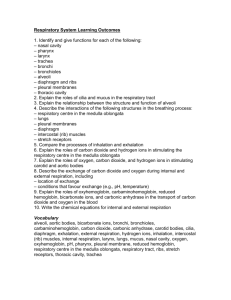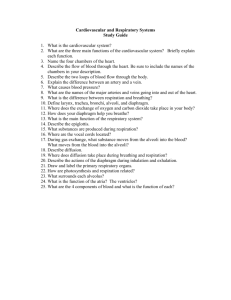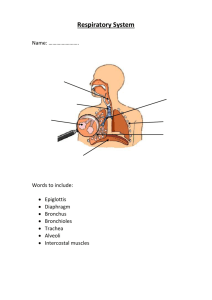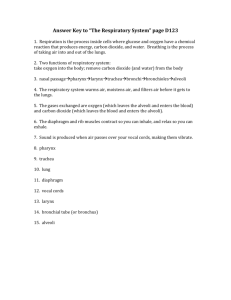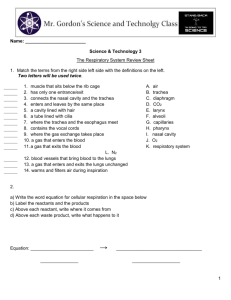Respiratory System
advertisement
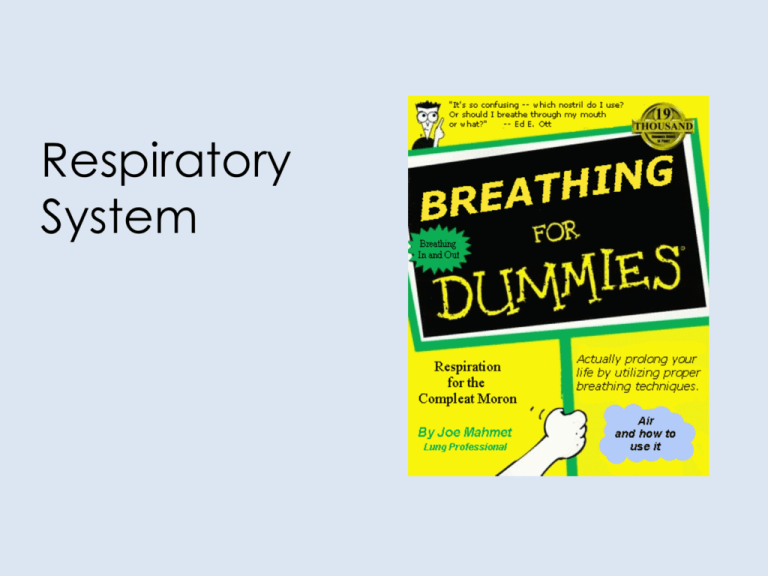
Respiratory System RESPIRATORY STRUCTURES OUR GOALS TODAY... Identify and give functions for each of the following: – nasal cavity – pharynx – larynx – trachea – bronchi – bronchioles – alveoli – diaphragm and ribs – pleural membranes – thoracic cavity Explain the roles of cilia and mucus in the respiratory tract Explain the relationship between the structure and function of alveoli Upper Respiratory Tract • Nostrils – mucousal cell layer • Pharynx – common passage for air and food • Epiglottis Trachea • Connects pharynx to smaller air passageways • C-shaped rings of cartilage – Keep Trachea Open – Structural Support • Larynx (vocal box) • Vocal Cords are composed to 2 tendons that adjust the pitch of sounds Bronchi • Trachea branch into bronchi • Cartilage Present • Bronchi branch further into bronchioles • Bronchiole Tree • End at Alveoli Alveoli • Blind sac-like ends on bronchioles • Millions per lung Alveoli • Highly specialized: – Walls only 1 cell thick to help with the diffusion of gases – Coated with lipoproteins in their inner surface to sustain surface tension (required so they don`t collapse when you exhale) – Stretch receptors – nerve endings that respond to stretch (send message to medulla oblongata that signals you to exhale when alveoli are full) – Highly vascularized with pulmonary capillaries for gas exchange and to prevent alveoli from drying out REMEMBER OUR GOALS TODAY... Identify and give functions for each of the following: – nasal cavity – pharynx – larynx – trachea – bronchi – bronchioles – alveoli – diaphragm and ribs – pleural membranes – thoracic cavity Explain the roles of cilia and mucus in the respiratory tract Explain the relationship between the structure and function of alveoli Assignment • Describe the location and function of the following structures: – Diaphragm and Ribs – Thoracic Cavity – Pleural Membrane MECHANICS OF BREATHING Our Goals Today... • Describe the interactions of the following structures in the breathing process: – – – – – – Respiratory centre in the medulla oblongata Lungs Pleural membranes Diaphragm Intercostal (rib) muscles Stretch receptors • Compare the processes of inhalation and exhalation • Explain the roles of carbon dioxide and hydrogen ions in stimulating the respiratory centre in the medulla oblongata • Explain the roles of oxygen, carbon dioxide, and hydrogen ions in stimulating carotid and aortic bodies Medulla Oblongata • Sensitive to the concentration of CO2 and H+ in the blood plasma • Considered toxins and must be excreted • When concentrations get high enough the medulla oblongata sends nerve impulses to the diaphragm and intercostal muscles Diaphragm & Intercostal Muscles • Diaphragm – muscles located below the lungs – Moves down when it contracts • Intercostal Muscles – between ribs – Moves rib cage up and out during contraction • These muscle contractions increase the volume of the thoracic cavity – creates a vacuum effect drawing air in (negative pressure) • Contraction requires ATP Pleural Membrane • • • • Double membrane 1 surrounds the lungs 1 lines the inside of the thoracic cavity 2 functions: – Allow lungs to slide in the chest cavity easily – Seals thoracic cavity (so negative pressure can develop for inhalation) • Pneumothorax Exhalation • Stretch receptors detect when the alveoli are stretched open • This signals the Medulla Oblongata to direct the diaphragm and intercostal muscles to relax • Diaphragm moves upwards and ribcage moves in and down – causing exhalation Chemoreceptors • Located in the aortic arch and carotid arteries – Sensitive to oxygen levels in the blood – If it gets too low then it will signal inhalation • Secondary mechanism – Blood Plasma CO2 and H+ primarily cause inhalation Remember Our Goals... • Describe the interactions of the following structures in the breathing process: – – – – – – Respiratory centre in the medulla oblongata Lungs Pleural membranes Diaphragm Intercostal (rib) muscles Stretch receptors • Compare the processes of inhalation and exhalation • Explain the roles of carbon dioxide and hydrogen ions in stimulating the respiratory centre in the medulla oblongata • Explain the roles of oxygen, carbon dioxide, and hydrogen ions in stimulating carotid and aortic bodies GAS EXCHANGE Our Goals Today... • Describe the exchange of carbon dioxide and oxygen during internal and external respiration, including – location of exchange – conditions that favour exchange (e.g., pH, temperature) • Explain the roles of oxyhemoglobin, carbaminohemoglobin, reduced hemoglobin, bicarbonate ions, and carbonic anhydrase in the transport of carbon dioxide and oxygen in the blood • Write the chemical equations for internal and external respiration Air is Conditioned in 3 Ways 1) Thoroughly Cleaned – Nose hairs and mucus of nasal passageways – Mucosal lining and cilia along trachea and bronchi (trap and move anything other than gases and move them up to mouth) 2) Temperature adjusted to around 37˚C 3) Becomes saturated with water Overview • Breathing (Inhaling and Exhaling) • External Respiration (gases exchanged between the lungs and blood) • Internal Respiration (gases exchanged between the blood and tissues) • Cellular Respiration (ATP production by mitochondria) External Respiration • In the alveoli blood is around 37˚C and has a pH of 7.4 – Under these conditions hemoglobin freely combines with oxygen • Hemoglobin has 4 binding sites for oxygen (oxyhemoglobin – HbO2) • HbO2 delivers O2 to tissues for internal respiration Internal Respiration • At the tissues the blood is around 38˚C and has a pH of 7.35 – These conditions cause HbO2 to release O2 as blood enters the capillary beds • O2 diffuses into tissues with water (capillary fluid exchange) Internal Respiration • At the venule side of the capillary recall that water re-enters the blood with CO2 due to osmotic pressure • pH and temperature conditions result in most of the CO2 reacting with H2O CO2 + H2O → [H2CO3] → HCO31- + H1+ – Catalyzed by Carbonic Anhydrase – Bicarbonate ions act as a buffer throughout the body – Hydrogen ions are transported in hemoglobin (HHb) so that they don`t change the pH of the blood Internal Respiration • Rest of the CO2 either bonds to hemogloblin (carbaminohemoglobin /HbCO2) • OR is transported as dissolved gas in the plasma • Blood enters the veins and goes through the heart and the pulmonary circuit back to the lungs Back at the Lungs... • Blood returning to the alveolar capillaries is transporting bicarbonate ions and some carbon dioxide gas • Hemoglobin is transporting either H+ or CO2 • Temperature is slightly lower and pH is slightly higher causing hemoglobin to release H+ and CO2 • Enzyme carbonic anhydrase catalyzes the reverse reaction HCO31- + H1+ → [H2CO3] → CO2 + H2O The end of the story... • Carbon dioxide diffuses into the alveoli and is exhaled • Some water is also exhaled • Hemoglobin is free to bind to oxygen Remember Our Goals Today... • Describe the exchange of carbon dioxide and oxygen during internal and external respiration, including – location of exchange – conditions that favour exchange (e.g., pH, temperature) • Explain the roles of oxyhemoglobin, carbaminohemoglobin, reduced hemoglobin, bicarbonate ions, and carbonic anhydrase in the transport of carbon dioxide and oxygen in the blood • Write the chemical equations for internal and external respiration
